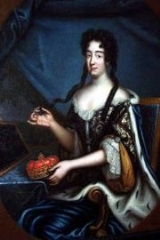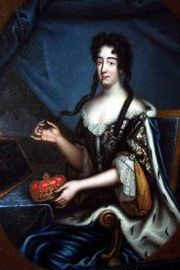
Eleonore d'Esmier d'Olbreuse
Encyclopedia

George William, Duke of Brunswick-Lüneburg
George William was duke of Brunswick-Lüneburg and ruled first over the Principality of Calenberg, a subdivision of the duchy, then over the Lüneburg subdivision. In 1689 he occupied the Duchy of Saxe-Lauenburg....
, and grandmother of George II of Great Britain
George II of Great Britain
George II was King of Great Britain and Ireland, Duke of Brunswick-Lüneburg and Archtreasurer and Prince-elector of the Holy Roman Empire from 11 June 1727 until his death.George was the last British monarch born outside Great Britain. He was born and brought up in Northern Germany...
. She was Countess of Wilhelmsburg from 1674 and Duchess of Braunschweig-Lüneburg from 1676. She was also the great-grandmother of Frederick the Great.
Life
Éléonore d'Esmier d'Olbreuse was born at the Château d'Olbreuse in Deux-SèvresDeux-Sèvres
Deux-Sèvres is a French département. Deux-Sèvres literally means "two Sèvres": the Sèvre Nantaise and the Sèvre Niortaise are two rivers which have their sources in the department.-History:...
near Niort
Niort
Niort is a commune in the Deux-Sèvres department in western France.The Latin name of the city was Novioritum.The population of Niort is 60,486 and more than 137,000 people live in the urban area....
, France
France
The French Republic , The French Republic , The French Republic , (commonly known as France , is a unitary semi-presidential republic in Western Europe with several overseas territories and islands located on other continents and in the Indian, Pacific, and Atlantic oceans. Metropolitan France...
into a Huguenot
Huguenot
The Huguenots were members of the Protestant Reformed Church of France during the 16th and 17th centuries. Since the 17th century, people who formerly would have been called Huguenots have instead simply been called French Protestants, a title suggested by their German co-religionists, the...
family of lower nobility. Her parents were Alexandre d'Esmier d'Olbreuse and Jacquette Poussard du Bas-Vandré et de Saint-Marc. She went to the royal court
Royal court
Royal court, as distinguished from a court of law, may refer to:* The Royal Court , Timbaland's production company*Court , the household and entourage of a monarch or other ruler, the princely court...
in Paris as a lady-in-waiting
Lady-in-waiting
A lady-in-waiting is a female personal assistant at a royal court, attending on a queen, a princess, or a high-ranking noblewoman. Historically, in Europe a lady-in-waiting was often a noblewoman from a family highly thought of in good society, but was of lower rank than the woman on whom she...
in the service of Marie de la Tour d'Auvergne, Duchess of Thouars, whose son had married Emily of Hesse-Kassel
Hesse-Kassel
The Landgraviate of Hesse-Kassel or Hesse-Cassel was a state in the Holy Roman Empire under Imperial immediacy that came into existence when the Landgraviate of Hesse was divided in 1567 upon the death of Philip I, Landgrave of Hesse. His eldest son William IV inherited the northern half and the...
, daughter of William V of Hesse-Kassel
William V, Landgrave of Hesse-Kassel
William V of Hesse-Kassel was the Landgrave of Hesse-Kassel in the Holy Roman Empire from 1627 to 1637....
, in 1648.
In the winter of 1664 Éléonore accompanied the Duchess of Thouars who visited her son in Kassel. There the beautiful Éléonore met the unmarried George William, Duke of Brunswick-Lüneburg
George William, Duke of Brunswick-Lüneburg
George William was duke of Brunswick-Lüneburg and ruled first over the Principality of Calenberg, a subdivision of the duchy, then over the Lüneburg subdivision. In 1689 he occupied the Duchy of Saxe-Lauenburg....
, who immediately fell in love with her.
Éléonore became his mistress and received the title Lady of Harburg. In 1666 their only child, Sophie Dorothea
Sophia Dorothea of Celle
Sophia Dorothea of Brunswick and Lunenburg was the wife and cousin of George Louis, Elector of Hanover, later George I of Great Britain, and mother of George II through an arranged marriage of state, instigated by the machinations of Duchess Sophia of Hanover...
, was born. In 1674 the child was legitimised and Éléonore became the Duchess of Wilhelmsburg. Two years later the couple could finally marry. It was a happy marriage.
Their daughter was married in 1682 to George Louis
George I of Great Britain
George I was King of Great Britain and Ireland from 1 August 1714 until his death, and ruler of the Duchy and Electorate of Brunswick-Lüneburg in the Holy Roman Empire from 1698....
, the son of her father's brother Ernest Augustus, Elector of Hanover for dynastical reasons. The marriage was a disaster. Finally Sophie Dorothea was imprisoned by her husband in the Castle of Ahlden
Castle of Ahlden
Ahlden House is a stately home at Ahlden on the Lüneburg Heath in Lower Saxony, Germany. It was built in 1549 as a water castle on the river Aller, which has since changed its course...
for the rest of her life. During the last years of her life, Éléonore cared for her daughter and tried to obtain her release, without success.
Éléonore d'Esmier d'Olbreuse died on 5 February 1722, nearly blind, in Celle Castle
Celle Castle
Celle Castle or, less commonly, Celle Palace, in the German town of Celle in Lower Saxony was one of the residences of the House of Brunswick-Lüneburg...
, Celle
Celle
Celle is a town and capital of the district of Celle, in Lower Saxony, Germany. The town is situated on the banks of the River Aller, a tributary of the Weser and has a population of about 71,000...
. She mentioned 342 persons in her will. She was buried in the Stadtkirche St. Marien (town church of St. Mary) in Celle.

